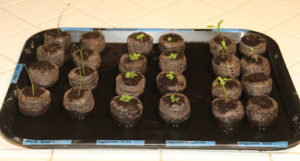Not only are the seeds growing, but equipment for the project has begun to arrive! For the average farmer/grower that may not be overly exciting, but for the technical team that is like a bounce-house at a 5-year-old’s birthday party. So, if the technical side is not for you, hold on, we won’t stray too far into the technology realm.
 HP has donated an MP9 Retail System, that we will be using as the server. It will be running Ubuntu 20.04. This is where the data will be stored, processed, and served as needed. The remote sensors will not be connected directly to the server. Instead, they will transmit data to the server via edge devices in the hoop houses.
HP has donated an MP9 Retail System, that we will be using as the server. It will be running Ubuntu 20.04. This is where the data will be stored, processed, and served as needed. The remote sensors will not be connected directly to the server. Instead, they will transmit data to the server via edge devices in the hoop houses.
To start with, the edge devices will be RaspberryPi devices, connected wirelessly back to the server. The sensors will be hardwired to the RaspberryPi devices.
For more details on the project’s technical side check out: https://wiki.lfedge.org/pages/viewrecentblogposts.action?key=OH

 Now back to the seedlings and their progress! We had some seeds that didn’t germinate. They were the cucumber, green beans, and sunflower seedlings. The tomatoes, peppers, onions, oregano, and cilantro are going strong. The seedlings are kept in our grow room with grow lights directly overhead. This simulates natural sunlight and prevents the seedlings from stretching towards the light source. They are bottom watered every two to three days, depending on need. As expected the tomatoes and peppers need more frequent watering than the oregano and cilantro because they are growing faster and consume more water. This will be one of the challenges we will be addressing with the project; varying levels of water consumption, based upon plant type and size, in a small grow/production environment.
Now back to the seedlings and their progress! We had some seeds that didn’t germinate. They were the cucumber, green beans, and sunflower seedlings. The tomatoes, peppers, onions, oregano, and cilantro are going strong. The seedlings are kept in our grow room with grow lights directly overhead. This simulates natural sunlight and prevents the seedlings from stretching towards the light source. They are bottom watered every two to three days, depending on need. As expected the tomatoes and peppers need more frequent watering than the oregano and cilantro because they are growing faster and consume more water. This will be one of the challenges we will be addressing with the project; varying levels of water consumption, based upon plant type and size, in a small grow/production environment.
